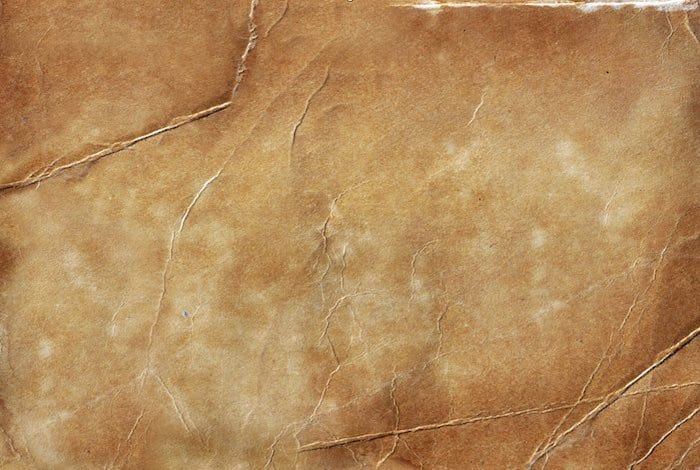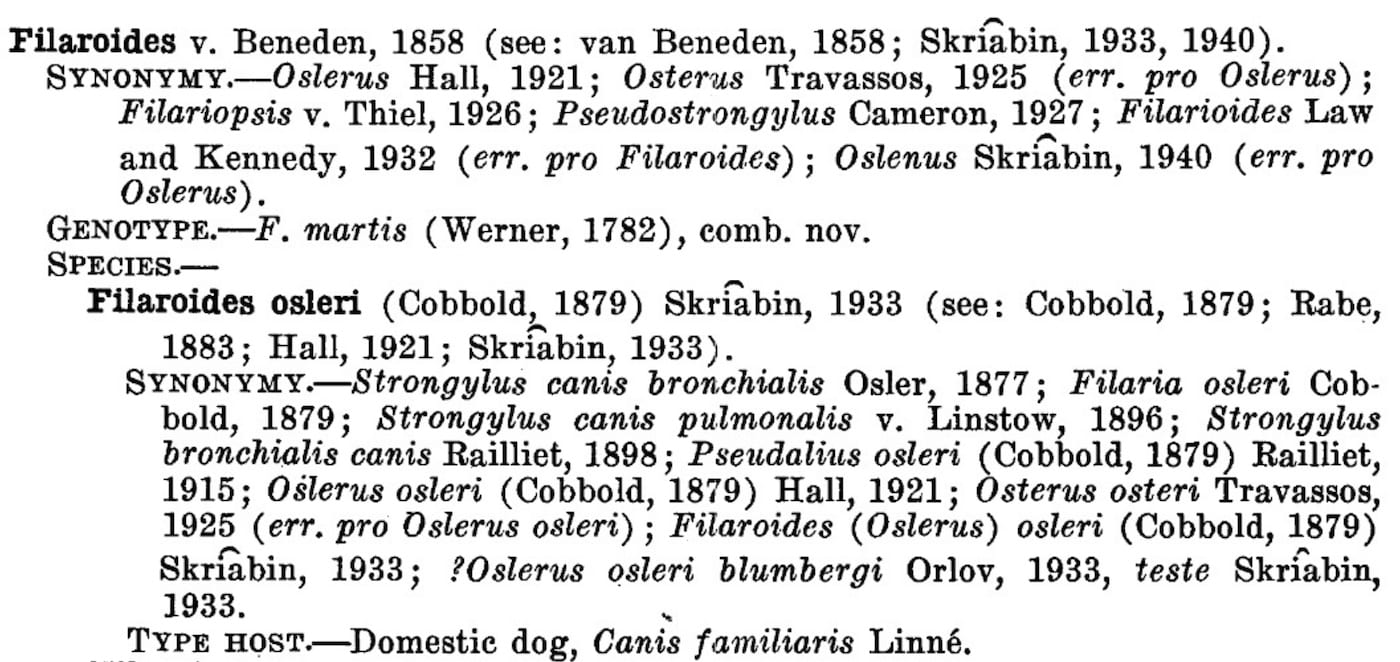Oslerus osleri
Sir William Osler was a man of not inconsiderable talent. A pathologist and clinician. A professor successively at McGill University, the University of Pennsylvania, Johns Hopkins University and Oxford University. Historian and bibliographer of medicine. A naturalist, microscopist, proponent of comparative physiology…and a veterinarian
The incessant concentration of thought upon one subject, however interesting, tethers a man’s mind in a narrow field
William Osler. Chauvinism in medicine
Osler first developed his passion for entozoa and comparative pathology as a high school student at Trinity College, Weston, Ontario under the tutelage of Rev. WA. Johnson, an ardent naturalist and botanist. Osler continued his scientific exploration at the Toronto School of Medicine with Dr. James Bovell, a keen naturalist and lecturer on the staff of the Ontario Veterinary College. Bovell encouraged Osler to pursue his studies of internal parasites in the dissecting rooms of the newly built veterinary college on Temperance Street, Toronto. His notebooks on entozoa highlight the ubiquity of disease in both man and animal and list parasites found in man, domestic and wild animals as well as birds and fish.
Osler played the major part in initiating the greatest revolution in the teaching and practice of medicine-both human and veterinary; he had joined the laboratory to the clinic to help end empiricism
Thomas W. M. Cameron, 1950
In 1876, Osler began teaching parasitology, physiology and later pathology at the Montreal Veterinary College. He used post mortem human material to teach the veterinary students, supplemented by animal material. At meetings of physicians or veterinarians in Montreal, Osler exhibited pathological tissue specimens of disease from cattle, horses and swine as well as dogs. Having studied with Virchow in Berlin, Osler expounded the concept of comparative pathology and the maxim that there is only one medicine.
Osler was able to bring his famous ‘bedside teaching’ methods to the stables
David A Murphy, 1960
Osler presented the inaugural address at the Montreal Veterinary College on two occasions. “The relations of animals to man” (1876) and “Comparative Pathology” (1878)
You will not be long students before you find out that similarity in animal structure is accompanied by a community of disease, and that the ‘ills which flesh is heir to’ are not wholly monopolized by the ‘lords of creation’
Osler, 1876
Osler published a few papers in the realm of veterinary pathology ranging from the verminous bronchitis (1877) and the pathology of hog cholera (1878) to echinococcus transmission (1882) and infected pork supplies in Montreal (1883)
Eponymous recognition
Please indulge the author one classic example of Osler as an amateur veterinarian, comparative pathologist and Vice-president of the Montreal Veterinary Medical Association…
In January 1877, Osler was invited to investigate an outbreak of a pneumonic disease amongst young foxhounds belonging to the Montreal Hunt Club in Canada. His first paper, on parasitic bronchitis in dogs, was read before the Montreal Veterinarian Medical Association March 29, 1877.
Osler described the symptoms, defined the pathology and determined the cause of the respiratory condition following observation and careful postmortem work. He then went on to try and name the disease, on the basis of its etiology and pathology rather than providing a nondescript term such as “kennel cough”
Cough was not a prominent symptom, being absent in many cases. When present, it was short and husky, not the regular distemper cough. In the case brought to the infirmary the cough was well marked and was dry and short
…at the time of the visit only one pup was ill, presenting symptoms of diminished airspace in the chest…On the following day it was found at autopsy that in addition to the pneumonia there were numerous small parasitic worms in the trachea and bronchial tubes
The course of the epidemic was short, lasting six or seven weeks, a sufficient time, however, to destroy almost all the pups in the kennels. The origin of the epidemic must, I am afraid, like that of so many other diseases, remain obscure .. .
Osler, The Veterinarian 1877
1879 – Osler suggested the name ‘Strongylus canis bronchialis‘ and sent specimens to the eminent English helminthologist, Thomas Spencer Cobbold (1828-1886) to further identify the worms. Cobbold found the worms to be Filariae and renamed them Filaria osleri.
In this place may be mentioned Dr Osler’s Strongylus canis bronchialis. The largest males measure 1/6″ and the females fully 1/4″. In the worms sent to me by Prof. Osler. I saw no evidence of strongyloid structure, and in his description he avoids all mention of the presence of any caudal hood in the male. I regard the worms as Filariae (F. Osleri, Cobbold).
Cobbold TS. 1879: 304
1921 – The American parastitologist, Maurice Crowther Hall (1881-1938) proposed the creation of a new genus for this parasite namely Oslerus and Filaria osleri was then known as Oslerus osleri
One of the species for which a new genus is necessary is Filaria osleri from the trachea and bronchi of the dog…it has none of the distinctive characters of Strongylus in even the broad sense…it was renamed Filaria osleri by Cobbold in 1879…but the fact that the worm has so little in common with Filara makes it advisable to remove it from this genus. As it does not seem to fit any existing genus, I am proposing a new genus for it, naming the genus in honor of the late Dr. William Osler, who discovered the worm and after whom the species is named. Tentatively the worm is referred to the super-family Spiruroidea. New genus OSLERUS
Hall MC. 1922; 59: 541-542.
1943 – Ellsworth Charles Dougherty (1921–1965) taxonomy proposal saw a final change to its inclusion in the genus Filaroides, and the now accepted name Filaroides osleri (Cobbold, 1879).
LITFL References
- Lessons from Osler 001 – Work, the Master Word in medicine
- Lessons from Osler 002 – Fun and a sense of humor
- Lessons from Osler 003 – the art of observation
- Lessons from Osler 004 – treat the patient, not the disease
- Lessons from Osler 005 – Why examinations are necessary
- William Osler: Oslerisms
- Sir William Osler (1849 – 1919) the history of Osler nodes and ephemeral Oslerisms
Oslerus Osleri References
- Osler W. Verminous bronchitis in dogs. The Veterinarian 1877; 50: 387-397
- Osler W. On the pathology of so-called pig typhoid. Veterinary Journal and Annals of Comparative Pathology. 1878; 6(6): 385-402
- Cobbold TS. Parasites; a treatise on entozoa of man and including some account of ectozoa. London: Churchill. 1879: 304
- Osler W. On echinococcus disease in America. American Journal of the Medical Sciences 1882; 84(1): 475-480.
- Osler W, Clement AW. Parasites in the pork supply of Montreal. Can Med Surg J 1883; 11: 325-326.
- Hall MC. Two new genera of nematodes, with a note on a neglected nematode structure. Proceedings of the United States National Museum. 1922; 59: 541-546.
- Dougherty EC. The genus Filaroides van Beneden, 1858, and its relatives: Preliminary note. Proceedings of the Helminthological Society of Washington. 1943; 10(2): 69-74.
- Cameron TWM. Sir William Osler and parasitology. The Journal of Parasitology 1950; 36: 93-102.
- Murphy DA. Osler, now a veterinarian. Can Med Assoc J. 1960 Jul 2;83:32-5.
- Dorrington JE. Studies on Filaroides infestation in dogs. Onderstepoort J. vet. Res. 1968; 35(1): 225- 286
- Saunders LZ. From Osler to Olafson. The evolution of veterinary pathology in North America. Can J Vet Res. 1987 Jan; 51(1): 1–26.

eponymictionary
the names behind the name

